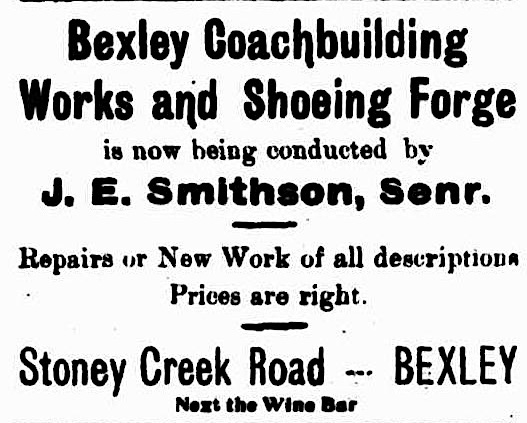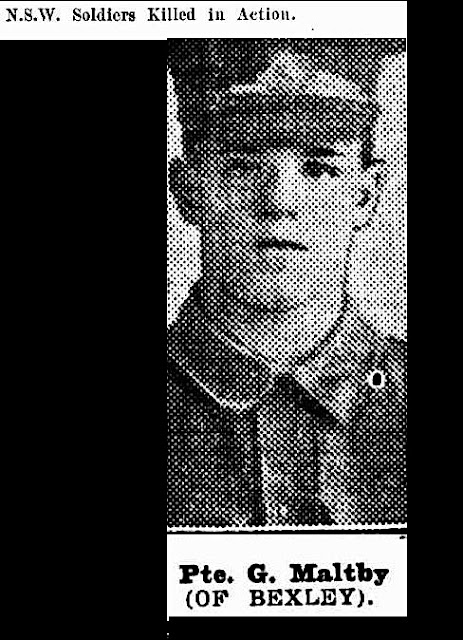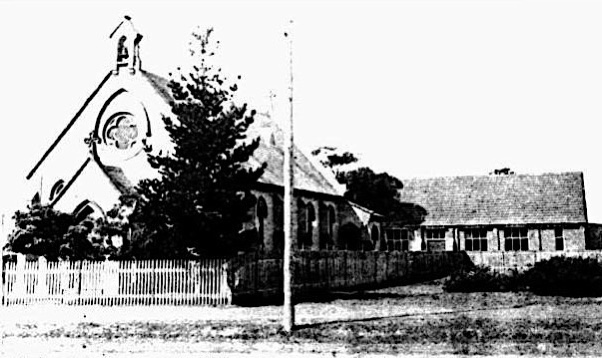Gweagal and Bidjigal People
The Bexley area is part of the traditional lands of the Gweagal and Bidjigal people.
The Gweagal lived on the southern side of the Georges River and Botany Bay, towards the Kurnell Peninsula.
They used barbed spears and fishing lines with hooks made from crescent-shaped shells to catch fish. Birds and their eggs, possums, wallabies and goannas were also a part of their diet.
Aboriginal Middens (rubbish heaps) have been found along tidal sections of the Georges River, full of shells and fish bones.
They are part of the Dharug language group.
Pemulwuy's left eye was "blemished" and one foot turned. The foot injury is said to have been made with a club showing that he was a “clever man”.
 |
| Painting of Pemulwuy, the leader of the Aboriginal resistance in the Bidjigal clan. Samuel John Neele (1758-1824) - State Library of Victoria |
1800s
Thomas Sylvester was granted land in about 1810. This land, “Sylvester’s Farm” was purchased by a free settler, James Chandler in 1822, who named the suburb after his birthplace, Bexley, in London, England.Chandler soon afterwards, petitioned Governor Sir Thomas Brisbane and was granted 1200 acres (4km2) of land in “any part of the colony already surveyed” and four convict servants.
It was the land adjoining his existing property that Chandler acquired, and this later became Bexley. (also some parts of Bexley North, Rockdale and Kogarah). Chandler also established a shop at 99 Pitt Street, Sydney.
Chandler became known locally as the "Squire of Bexley", but bushrangers and escaped convicts occupied the property, so Chandler sold the land to Charles Thompson in 1836.
The estate was heavily timbered and a track through the centre used by timber-getters, is today called Forest Road.
Lydham Hall, the oldest surviving residence in the area, stands on part of the original land grant of 1822.
In the early days, most of the buildings were slab huts with bark rooves (1.)
 |
| Example of a slab hut built by settlers in Australia |
 |
| Sydney Morning Herald (NSW : 1842 - 1954), Friday 16 April 1847 |
John Downey's Cottage on the corner of Downey Street and Mimosa Street West Bexley, was built in 1855, by the Irish immigrant John Downey.
 |
| Sydney Morning Herald (NSW : 1842 - 1954), Saturday 30 August 1856 |
The railway line to Hurstville opened in 1884 and a two-tier wagonette and hansom cab conveyed train travellers to their home.
1890s
A heritage-listed house, "St Elmo" on Harrow Road, Bexley, was designed by William Kenwood and built in 1897 in Victorian style, with some Federation features, for Joseph Palmer.
1900s
Bexley had its own council, known as the"'Municipality of Bexley" from 1900-1948. The council would later be amalgamated with the Municipality of Rockdale.
Stone’s Slaughterhouse in Stoney Creek Road began operations in the 1890s.
| Australian Town and Country Journal (Sydney, NSW : 1870 - 1919), Saturday 24 November 1900, |
The Arncliffe to Bexley steam tramway officially opened on the 13th October 1909 and operated until the 1st January 1927. It ran from Arncliffe Station along Wollongong Road to a terminal loop located between Preddy's Road and Mimosa Street in Bexley.
 |
| The Arncliffe to Bexley steam tramway officially opened on the 13th October 1909 . Australian Town and Country Journal (Sydney, NSW : 1870 - 1919), Wednesday 20 October 1909 |
 |
| Bexley Public School, NSW, 330-354 Forest Rd,Bexley in 1914. |
 |
| St George Call (Kogarah, NSW : 1904 - 1957), Saturday 6 November 1915 |
 |
| BOYS OF THE' SALVATION ARMY HOME AT BEXLEY, NEAR SYDNE. Daily Telegraph (Sydney, NSW : 1883 - 1930), Monday 3 April 1916 |
 |
| N.S.W. Soldiers Killed in Action. Pte. G. Maltby (OF BEXLEY). Australian Town and Country Journal (Sydney, NSW : 1870 - 1919), Wednesday 22 May 1918 |
1920s
 |
| Sun (Sydney, NSW : 1910 - 1954), Thursday 1 November 1928 |
 |
| St Elmo, house in Harrow-road, Bexley, where three women and a man were shot dea , and another man was critically wounded. Sun (Sydney, NSW : 1910 - 1954), Thursday 1 November 1928 |
 |
| Propeller (Hurstville, NSW : 1911 - 1954), Friday 13 July 1934. ABORIGINAL / FOOTBALLERS. In the Soccer grounds of Prince Edward Park, Carlton, next Sunday afternoon, commencing at 3 o'clock, a team of Aboriginal . footballers from La Pe-rouse will play a $10 challenge match against Bexley Waratahs "A" grade team The early match 2 o'clock will be between "Sun" Newspapers and the Bexley Wanatah "B" Grade team. During the afternoon tho aboriginals will give. an exhibition of boomerang throwing supplemented by music from a gum-leaf band. |
|
EARLY BEXLEY:
Resident's Reminiscences.
Mr. and, Mrs. W. Richardson, of Bayview Street, Bexley, recently celebrated their golden wedding, being married at Bexley in 1886. Howling dingoes in the Bexley gullies and piggeries where the main shopping centre now stands were recalled by Mrs. Richardson in looking over fifty years of progress.
She was born in a large house on the site now occupied by the St. George Bowling Club, which was adjacent to what was then known as "Spring Creek." This water was so pure, owing to the springs, that chemists used to come from Newtown to take the water for medicinal purposes.
Her grand-mother, Mrs. Isaac Parkes, was known throughout old Bexley as old "Granny Parkes, " who acted as nurse and doctor to many people. She made her own ointments and medicines, and was a great boon to the workmen of that time, mostly timber-getters in Gannon's Forest.
Mrs. Richardson's grandfather was the toll-collector on the old toll bar gate in Gannon's Forest Road, where Clarence Street now is. This was the main route to Sydney from Bexley, although the road then was mostly quagmire in a dense forest.
Bexley residents could not see Botany Bay then, owing to the large trees, but they could hear the waves
beating on the shore. The area was wild and real bush, and Mrs. Richard-son said she could well remember on many occasions when dingoes would howl at night in the gullies, although they never gave any trouble by attacking people. These animals seemed content to remain in the gullies away from the little growing suburb.
Other early visitors to Bexley were (A)boriginals, who often looked in on their way from Tom Ugly's Point. They secured provisions and were quite friendly with the new settlers, leaving in large companies with donkeys to carry the loads.
Propeller (Hurstville, NSW : 1911 - 1954), Thursday 2 April 1936
PIONEER DAYS OF BEXLEY
When I was a girl we used to carry our washing down the hill and do it beside the creek. In those days it was nothing unusual for me to have to carry nine buckets of water from the spring up to our house on Forest Road each morning before breakfast.”
The St. George Theatre opened in July, with a plain facade. In 1939, it was re-modeled in a Streamline Moderne style. It was re-named Odeon in August 1952 but closed on 12th September 1959.
 |
| Postwoman Mary Davenport delivering mail. Mary wears a Postmaster General's (PMG) uniform and peaked cap and worked at the Bexley Post Office.1942, AWM |
 |
| A special A.I.F. broadcast interview of families who live near Bexley Park, Bexley, NSW, ABC weeklyVol. 4 No. 1 (3 January 1942) |
Bexley man reaches 100
Thunderbolt stole, returned his watch
MR. JOHN GROTH, of 61 Stoney Creek-road, Bexley, who has just celebrated his LOOth birthday, had his gold walch stolen and returned lo him the next day by Thunderbolt, the bushranger, in 1863.
Mr. Groth was 20 and a shepherd in the Narrabrl district. He had arrived from Denmark the year before, and when held up somewhere betweenArmidale Armidale and Narrabrl. He could only protest in Danish. The next day, the mail-man told Thunderbolt, with whom he was friendly, that he had taken from a poor shepherd. Thunber-bolt returned the watch, saying: "I don't want to take things from these people. Give it back to hint."
Bexley man reaches 100 (1943, October 10). The Sun (Sydney, NSW : 1910 - 1954),
 |
| London, England. 1945-03-05. Portrait of 420284 Flight Lieutenant H. J. Shipley, of Bexley, NSW. AWM |
In 1946, Wanslea, the Victorian mansion, became Rachel Forster Hospital for Women, and operated until 1971,
 |
| Armidale Express and New England General Advertiser (NSW : 1856 - 1861; 1863 - 1889; 1891 - 1954), Wednesday 25 September 1946 |
 |
| Baby Health Centre, Bexley, Sydney, 1946, Building and engineering.No. 11 (25 November, 1946) |
1950s
 |
| Dawn Anzac Service At Bexley. Daily Mirror (Sydney, NSW : 1941 - 1955), Wednesday 25 April 1951 |
 |
| Forrest Inn, Bexley, NSW, 1950s, ANU |
 |
| New School at Bexley North, NSW, (11 March 1953) |
 |
| New School at Bexley North, NSW, (11 March 1953) |
1970s
 |
| DGT
Leyland OPD2-1 2497 with a body built by Clyde in 1951 on an HCVA
Special Hiring showing Route 472 Bexley North Station in Bexley Road,
Bexley North. City of Sydney Archives, 1972 |
 |
| DGT Leyland OPD2-1 2497 with a body built by Clyde in 1951 on an HCVA Special Hiring showing Route 492 Rockdale Station in Forest Road at Bayview Street, Bexley. City of Sydney Archives, 1972 |
 |
| PTC Leyland Atlantean 1192 with a body built by PMC in 1972 showing Route 494 Drummoyne on an HCVA Tour in Frederick Street, Bexley. City of Sydney Archives, 1980- |
2000s
2024
502 Forest Road, Bexley, named “Forest Manor”, is scheduled for demolition.
 |
| 502 Forest Road, Bexley, NSW, named “Forest Manor” |
Around Bexley
 |
| “Montrose” in Broadford Street, Bexley, NSW, built circa 1887. |
 |
| St Gabriel's Catholic Church on Stoney Creek Road, Bexley, NSW, was built in 1952 in the Post-War American Colonial architectural style |
 |
| The Bexley Uniting (formerly Methodist) Church, built 1825, Bexley, NSW |
 |
| Heritage house, Bexley, NSW |
 |
| Victorian Style building, in Bexley, NSW |
 |
| Heritage house, Bexley, NSW |
 |
| The Building in Bexley, NSW, dates back to the 1920s (Art Deco) (Ex Bank of NSW, the Commonwealth Bank Building) |
 |
| Bexley School of Arts, foundation stone laid, 1924, NSW |
 |
| The former Masonic Lodge on Forest Road, Bexley, NSW, was built in 1923 |
 |
| John Downey's Cottage on the corner of Downey. Street and Mimosa Street West Bexley, NSW, built in 1855, by the Irish immigrant John Downey |
 |
| St Elmo” in Harrow Road, Bexley, NSW, designed by William Kenwood for Joseph Palmer in 1897 |
 |
| Federation house at 580 Forest Rd Bexley known as "Brandlesome" was owned by the Formby family for four generations |
 |
| Art Deco-style at Bexley, NSW |
Things To See and Places To Go
The Salvation Army Museum

























































